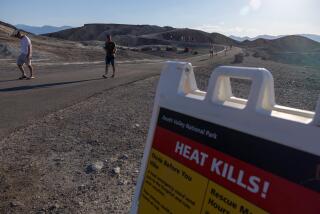BEING THERE : Into the Valley of Death
- Share via
The palm of my hand, extended out the car window, burns as we enter Death Valley. It’s a good sign: I’ve come to the hottest, driest place in the Western Hemisphere to see what hell on earth is like. Last week it was 118 here, but as my fellow desert zealot, Jay, and I descend into Furnace Creek, our thermometer reads a measly 108. Perhaps tomorrow will be worse.
The following morning, we step out of our air-conditioned room at the Furnace Creek Ranch into a promising oppressiveness--and a sea of Europeans. In summer, the whole national park is overrun with them. They come here because of the heat. “When they step off the air-conditioned buses and are blasted by the hot air,” says a ranch employee, “they get these big grins on their faces.”
By noon, the temperature reaches 111. We move from shady spot to shady spot, gulping ice tea and Diet Coke, one right after the other. Sure, 111 is hot, but I want blazing heat. I want an inferno. And, after all, the temperature in Death Valley once hit 134 degrees, a world record for many years. So, at 1 o’clock, we head for Badwater, a deadly little pond out on the salt flats that’s 282 feet below sea level. They say it gets hotter there.
At Badwater, I take out my thermometer and two Germans rush over and take its picture. The temperature is 115, so hot that passing trucks leave tracks in the asphalt.
That’s hot enough for Jay, who wants to go back to the swimming pool. But I still want to know what Death Valley would be like on a really hot day, not just this 115 pittance. So we turn down Artist’s Drive, a canyon of rainbow rock, roll up the windows and crank up the car heater. The temp starts rising fast. At 119, I get unbearably thirsty and discover there’s no water in the car. At 121, the soles of my tennis shoes feel mushy. At 123, everything in the car, including the wheel, is too hot to touch. At 125, Jay threatens physical violence. At 127, I open the window, and a rush of 115-degree air feels like a cool mountain breeze.
Park Ranger Ann Titus claims heat is like that: It’s all relative. She’s worked at Glacier National Park and was used to subzero temperatures. But now she puts on a thick pile coat whenever it drops below 70. “I went to Riverside last summer,” says Titus, “and I thought I was going to freeze.”
More to Read
Sign up for The Wild
We’ll help you find the best places to hike, bike and run, as well as the perfect silent spots for meditation and yoga.
You may occasionally receive promotional content from the Los Angeles Times.






